Playing Cards Around the World and Through the Ages
The complicated lineage of our ubiquitous decks.
The history of playing cards is, in one major way, just like the history of the hammock. Starting, depending on who you ask, sometime around the ninth century, or the 11th, or the 13th, playing cards spread because everyone who saw them for the first time immediately recognized how much fun they could be, tried to get some for themselves, and introduced them to everyone they know. That’s how the hammock spread, too.
But playing cards, unlike hammocks, have an air of mystery about them. The amount of things, basic things, that nobody knows about playing cards is astounding. For something that is itself a document, playing cards are impressively undocumented.
For much of the world, clues to those mysteries are invisible. One deck dominates the modern playing card industry: 52 cards, four familiar suits, two colors, inflexible dimensions. But it is not the only deck. In other decks, there are bells and acorns and swords, cards that are circular or incredibly tall and thin, decks with more than a hundred or fewer than 25 cards. Given how much time we’re all spending at home right now, the idea of a vast array of playing card variations, all with their own world of games, is incredibly enticing. But where these all came from, well, that’s one of the mysteries.
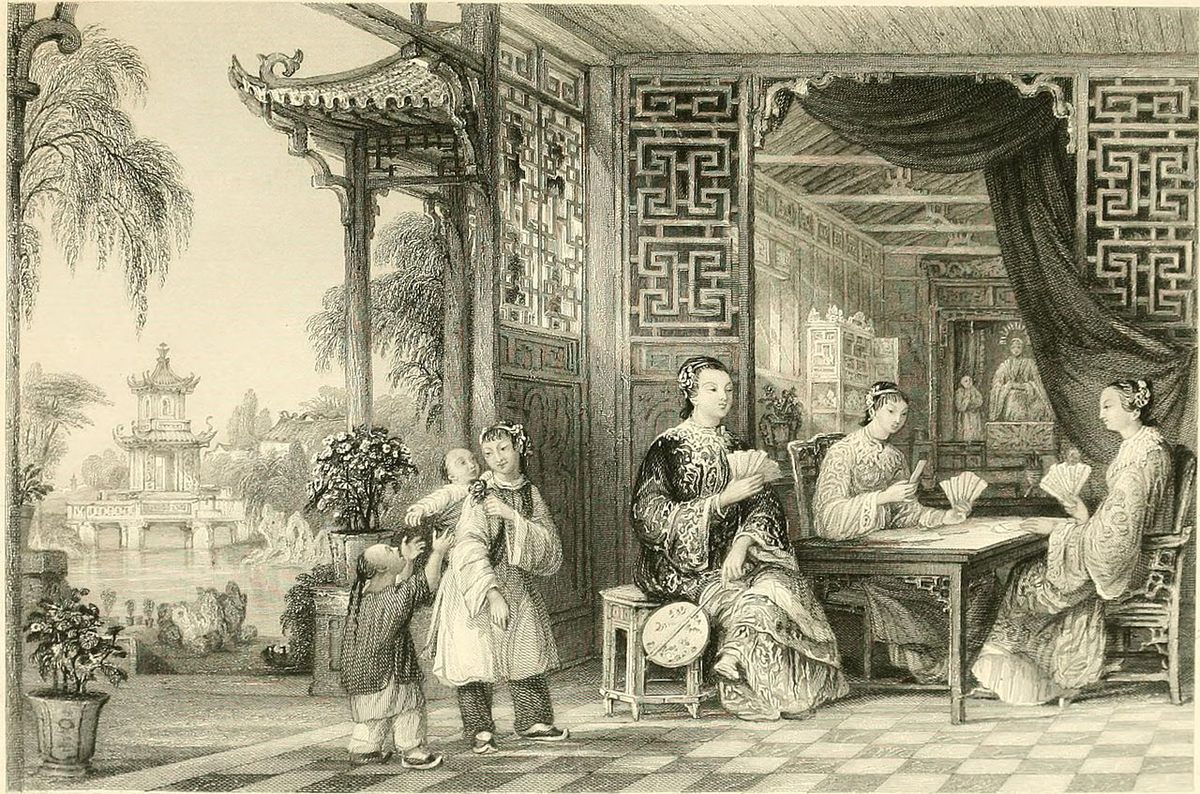
The most basic question in the history of playing cards—where were they invented, and by whom—has no conclusive answer. “There are different theories about that,” says Peter Endebrock, a playing card historian, scholar, and collector from Germany. “They come from Asia, that’s the one thing that’s rather clear, but where exactly they came from and how they came to Europe, that’s not clear.” Playing card historians generally assume that playing cards have their origins in either China or Persia, possibly India, but again, documentation is scarce.
Some sources cite a Chinese game called yezi ge, which translates to “game of leaves,” as the first game to use playing cards. There are references to yezi ge being played as early as the 800s. But a 2009 study found that there is no indication that the “leaves” actually referred to playing cards, and supposes that the “leaves” may have actually been the pages of the game’s instruction book—and that the game used dice, as other Chinese games of the time did. In fact nobody seems to have even suggested that yezi ge may have been a card game until the 15th century, which is right around the time that playing cards started to really take off worldwide. That 2009 study cites a 1294 police record as the earliest unambiguous record of playing cards. A couple of gamblers in Shandong, China, were arrested, and their cards and printing blocks confiscated.
This is a recurring problem with candidates for the oldest playing cards in the world: It’s unclear if they even are playing cards at all. There are fragments of card-sized parchment dated to around the 13th century in a couple of museums, including the Keir Collection of Islamic Art in Dallas, but it’s not known for sure if these were actual playing cards or simply scraps of parchment that sort of look like playing cards.
We are, to be clear, differentiating between cards and tiles. Mah-jongg, for example, uses suits and numbers and symbols on individual game pieces, but these are, traditionally, tiles rather than cards. Cards are printed; tiles are sculpted. The line can get a little blurry, since you can play mah-jongg with cards and, I suppose, you could create a solid, un-shuffle-able set of poker cards out of wood, but scholars view them differently. Tile games are probably older than card games, with dice games and board games so ancient they date as far back as recorded history goes.

The oldest complete deck of playing cards known to the world is called the Cloisters Deck, named for the museum—the Metropolitan Museum of Art’s medieval Cloisters location—in which it was identified and dated. It’s from the late 15th century, probably made in the Burgundian Netherlands territory, and very recognizable by modern standards. There are 52 cards in four suits, with both numbered and face cards. The other most famous very old deck is called the Mamluk cards, located in the Topkapı Palace Museum in Istanbul. It’s not entirely complete deck, and date to some time around 1500. (Some of the cards in the deck are probably much younger, since it appears that somebody snagged one from another deck to replace something missing, like using a chess piece as a hotel in Monopoly.)
Most sources agree that playing cards appeared fairly suddenly in Europe sometime before these known decks. Michael Dummett, a prominent philosopher, academic, and one of the founders of the International Playing-Card Society (which today includes most prominent card scholars) suggests it was in the last quarter of the 1300s. This happens to be around the time of significant interaction between Christian Europe and the Islamic powers, in the form of the Crusades. During the Crusades, huge groups of Christian and Muslim soldiers fought, but that probably isn’t all they did. “When soldiers had nothing to do, which is most of the time, what do they do? Today they play video games, but in those days they play cards,” says Emilia Maggio, a historian, translator, and council member at the International Playing-Card Society. Maggio grew up in Sicily, and much of her focus is on Italian cards.
It seems wholly possible, though unproven, that playing cards were introduced to Europe through bored soldiers during the Crusades. Those Mamluk cards in Istanbul, for example, are basically identical in arrangement to modern Spanish cards, which makes sense, given that Granada was literally an emirate until 1492.
However playing cards arrived in their hands, Europeans freaking loved them. At first they were primarily for the rich, because they had to be hand-painted and could be extremely elaborate, with exotic dyes and beautiful designs. The Mamluk cards, for example, are so thoroughly ornamented that it can be difficult to tell which card each one even is. Even before Gutenberg’s printing press, other, less sophisticated presses were able to create playing cards, since they require much less variation than, say, a book. Individual countries or regions within Europe created who knows how many different decks. A rich son of a Florentine family may have come home after playing cards on his Grand Tour and asked a local painter to make up a set of cards for himself, creating a whisper-down-the-lane collection of different decks.
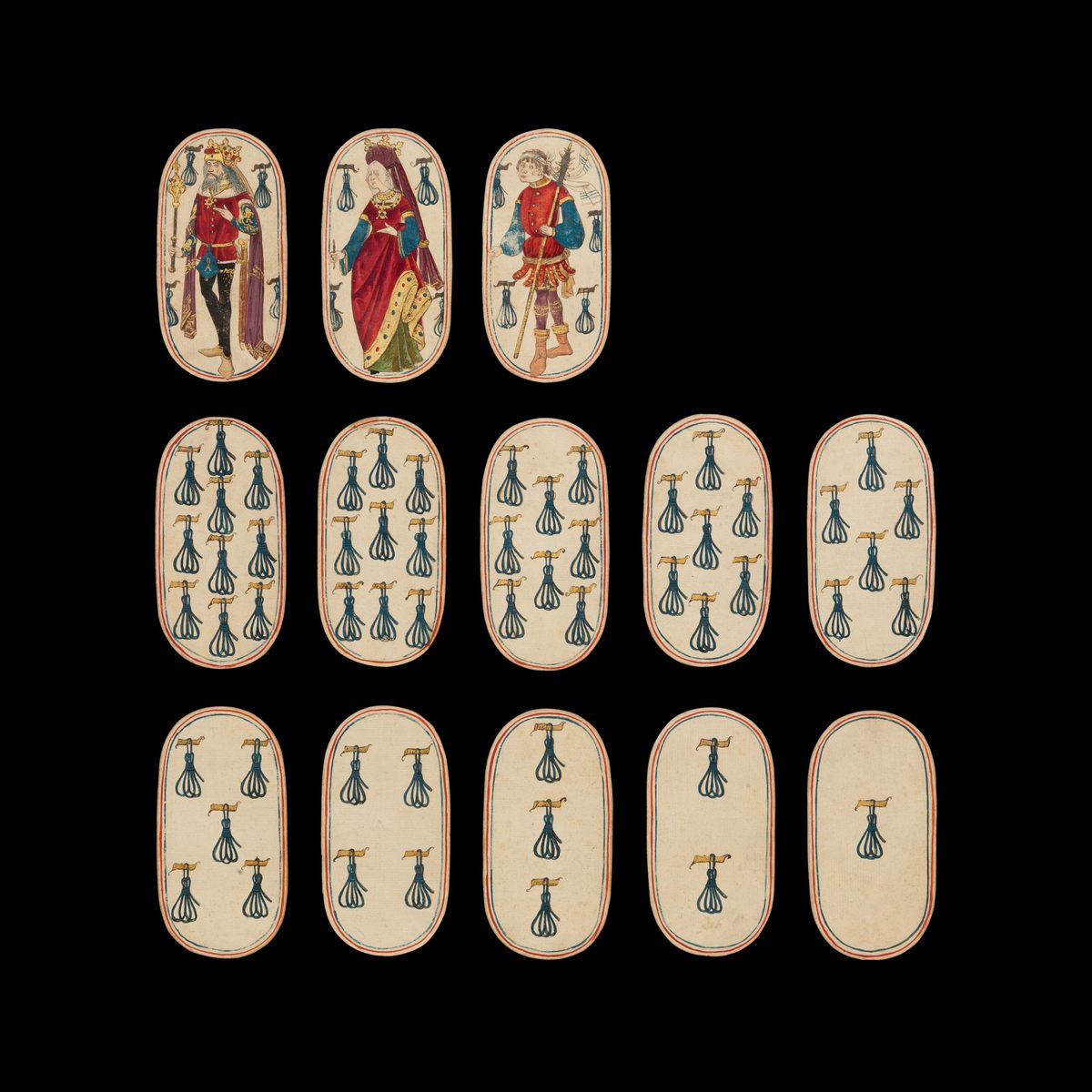
The Cloisters deck uses hunting-themed suits, which were fairly common. The suits might be hunting dogs, stags, lures, that kind of thing. Some had suits representing the ruling families of Europe, like a fleur-de-lis for France. But by the end of the 15th century, with the printing press and the popularity of cards achieving critical mass, the design and layout began to be standardized. There are some obvious advantages to such recreational standardization. You can play the same games with different decks because those decks all contain the same cards, in the same number, with the same suits.
But there wasn’t a single dominant standard, at least not yet. In Europe, four different decks came to be used widely: the German, Swiss, French, and Latin (the latter used in Spain and Italy, and having very slightly different designs of the same suits). These are delineated from the late 1400s on. It’s assumed that the Latin deck came first, since it’s pretty much exactly the same as the Islamic Mamluk cards, followed by the Swiss, German, and then French.
The Mamluk cards, as well as modern Italian and Spanish decks, use a deck of usually 40 cards, though sometimes there are decks of 48 or 52. They’re split up into four suits: Cups, Coins, Swords, and Batons (the latter sometimes called sticks or cudgels). A 40 card deck has “pip cards,” or number cards, from one to seven, along with three face cards, for each suit. The face cards are fante (knave, or jack), cavallo (knight), and re (king). Those words are Italian; the Spanish versions are similar, as many words in Italian and Spanish are.
German decks typically have 32 or 36 cards, in four suits: Acorns, Leaves, Hearts, and Bells. The closely related Swiss deck has 36 cards in four suits, with Roses in place of Leaves. None of these three decks—Latin, German or Swiss—divide those suits further by color. Only the French does that. The German cards also differ in their composition; to come up with those 32 cards, each of the four suits has “pip cards,” or number cards, from seven to 10. The face cards are unter (“under knave,” a junior officer), ober (“over knave,” senior officer), könig (king), and ass (ace). Those pip and face cards are essentially the same in the Swiss deck.
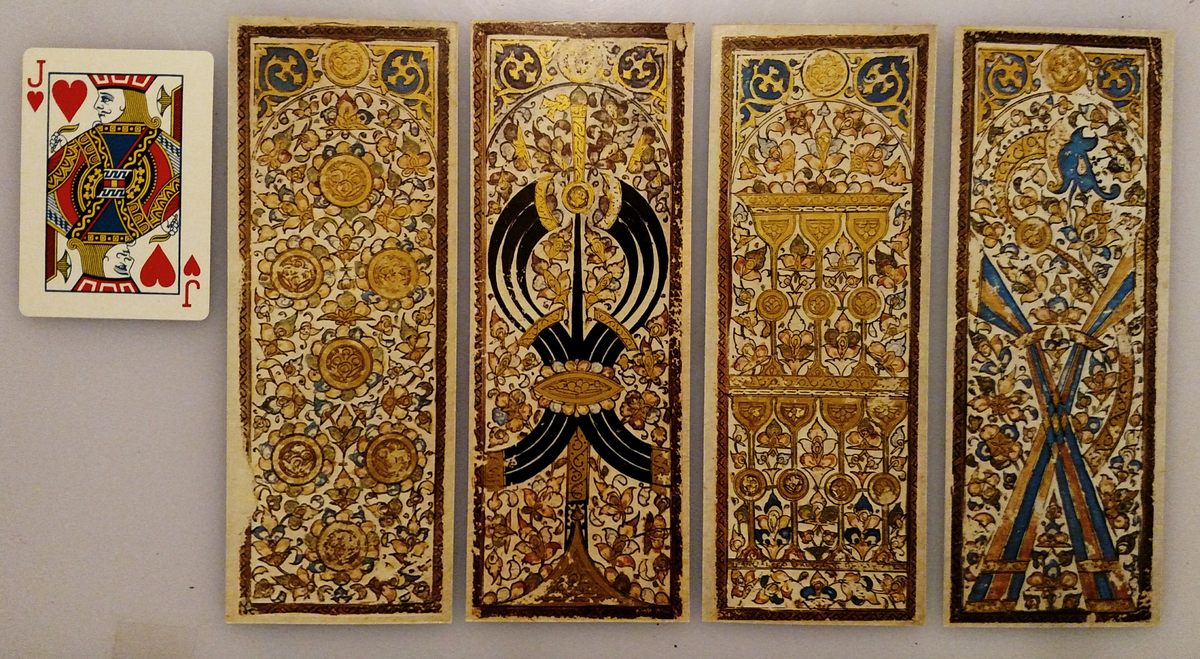
The French deck is by far the most popular playing card deck in the world. Even in countries with their own standardized decks, such as Italy or Germany, people often play with the French deck. It’s got 52 cards of four suits (Hearts, Diamonds, Clubs, Spades), in two colors (red and black). The French deck’s popularity is due to a few factors. For one thing, the suits are easily the simplest in design, which makes them easy and cheap to print. For another, that deck has been the favorite of the most aggressive imperialist powers of the past couple of centuries: France, the United Kingdom, and the United States. It also happens to be the deck used for some of the world’s most popular games, including bridge and poker, though the popularity of those games may be a result of the deck’s widespread use rather than a cause.
These four decks are the most cited in the West, but they’re not the only decks out there. Setting aside decks printed for specific games, such as Uno, there are tons of these. We also have to set aside tarot decks, which are kind of their own thing.
Just because it’s fascinating, here’s the deal with tarot. Researchers, especially Dummett (who’s sort of a legend in the community of playing card scholars), have made it a point to demysticize tarot decks. Tarot decks came later than suited decks, and were simply made up of new cards added to the existing playing card decks, first in Italy in the mid-1400s, where they were called “triumph cards.” (This later mutated into “trump.”) They were, according to all research, not designed for any occult fortune-telling, but rather for some fun new games, versions of which are still played today. Tarot games are annoyingly complicated trump games, sort of like bridge. The occult cartomancy trend dates only to the late 1700s, created by a French pastor who believed (totally incorrectly but very seriously) that the cards were a compendium of ancient Egyptian wisdom passed down by Thoth, the Egyptian god of knowledge. This pastor provided zero documentation of his beliefs, and scholars are pretty convinced there’s no truth to them, which makes using tarot cards for divination a little bit like trying to see the future with a pack of Uno cards. But tarot cards are elaborate and cool, so cartomancy took off.
Anyway, there are plenty of card decks outside of Europe. Japan, prior to European contact, had matching games played with painted shells. Interaction with Portuguese traders prior to Japan’s isolationist period introduced playing cards, which eventually evolved to be more Japanese. One game, uta-garuta, is a matching game of playing cards on which classical poems have been written. Later versions of Japanese playing cards include hanafuda, or flower cards, which have 12 flower-themed suits, one for each month, and 48 cards in a deck. Nintendo was originally founded to sell hanafuda cards and, in fact, still does.

In China, a deck called “money-suited” cards is believed by some to be an ancestor of the four-suited Islamic and European decks. This deck contains 38 cards in four suits, all of which are based on money: coins, strings of coins, myriads of strings, and tens of myriads (of strings, of coins). China, befitting a gigantic and diverse country which may or may not have invented playing cards in the first place, has many more playing card decks than that. Some games have had non-card pieces—such as those in dominoes or Chinese chess—turned into cards.
India has its own older style of playing cards, though it’s much less standardized than other decks. Most, though not all, of these decks, called ganjifa in most of the country and ganjapa in the state of Odisha, are circular. Designs, numbers of cards, and numbers of suits vary tremendously—from eight to 12 suits and 48 to 120 cards. And some cards have been printed in circular Indian style, but with French suits and card designs.
There are many, many smaller or recently extinct decks out there. One of my favorites is the deck of the Galician Jews, who made their own cards to avoid using the European ones, laden with Christian imagery. The deck, and the blackjack-like game played with it, is called kvitlech, and the deck includes only 24 cards. It’s mostly dead now, but was played on Chanukah, where it must have been much more fun than playing dreidel.
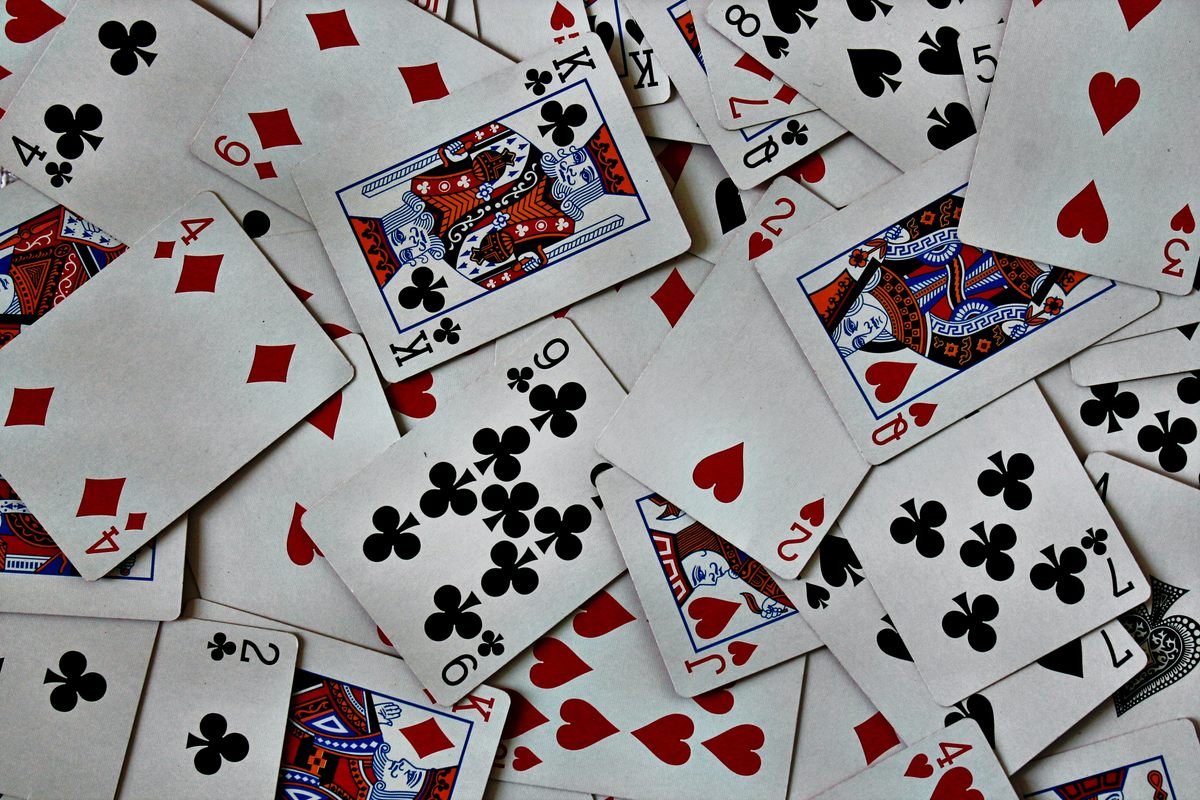
For the European decks, how and why their particular suites of suits developed, nobody really knows. “There are many theories about that, but I don’t really believe in any of them, because they cannot be proved,” says Endebrock. Those theories all feel like guesswork, just-so stories that only kind of fit the evidence. Maybe some suits are meant to indicate aristocracy and others peasantry (Diamonds and Spades). Maybe some were for peace and some for war (Cups and Swords). What seems most likely is happenstance: a rich count in Italy or Bavaria or wherever decided to print some cards for fun, and asked his painter to make some acorns, because he liked oak trees.
Today, the popularity of the French deck and games that use it are having a strangling effect on most of the other decks out there. “In the beginning of the last century, there was a clear division where people used French and where they used German,” says Endebrock, who is German. “But nowadays they use French-suited cards everywhere in Germany.” That’s the story worldwide. But maybe it shouldn’t be. I’ve never thrown down an Unter of Bells in triumph. It seems worth doing.






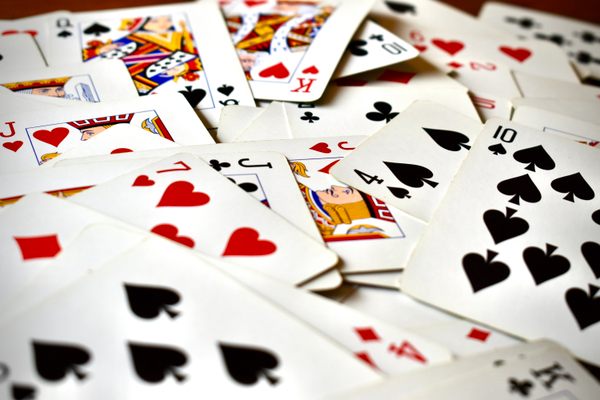











Follow us on Twitter to get the latest on the world's hidden wonders.
Like us on Facebook to get the latest on the world's hidden wonders.
Follow us on Twitter Like us on Facebook